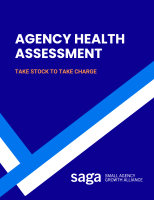Past performance may not be a guarantee of future results, but it certainly provides a wealth of insight that can help you plan for success.
Looking back may provide the greatest value when it comes to identifying your agency’s ideal clients. Your previous successes (and failures) give you valuable information that you can use to repeat what works and avoid what doesn’t.
Many agency owners go about targeting clients in the wrong way. They start by asking who needs help or what industry is hot right now.
As more jurisdictions began to legalize the sale of cannabis products, this became a go-to target for many agency leaders. They saw a gold rush and wanted to be part of it.
For some, it was a natural fit based on the kind of work that they had done before. For others, it was merely an old-fashioned land-grab that didn’t leverage any past success to produce results – either for the clients or the agency itself.
Lean on what you know
Many of us started our agency businesses by signing up previous employers or organizations we had contact with in our last job.
We took advantage of what we know (and who we know) in order to build out that initial book of business that would launch our entrepreneurial journey.
Often this is less a question of intent and more representative of the path of least resistance. But it often works.
At some point, though, we are tempted by greener pastures or our own creative curiosity to venture beyond the safe confines of what we already know.
That’s a natural – and healthy – instinct that can serve your business well because it helps to ensure that you don’t stagnate.
At the same time, you should not be hasty to give up on the kind of work and clients that you already grasp well. If you know what to expect and how to get results, you are likely to be able to do so more consistently and more profitably.
Great results mean that you improve your client retention rates, while better efficiency helps you to maintain solid margins on the work that you do.
Review your current and previous clients
To leverage your track record for planning purposes, start by building a list of all of the clients that you have had during the past few years.
Be thorough and include all of the clients, including those that were short-term and especially the ones that you might prefer to forget!
Once you have generated this list, it’s time to start looking at some of the characteristics of each engagement.
Your evaluation list should be based on what you value most in each relationship, but here are a few things that probably ought to be part of everyone’s criteria:
- Success. Were you able to achieve the expectations that your client had?
- Profitability. Was this client or project good for your bottom line?
- Relationship. Did the client treat everyone with respect and hold up their end of the bargain (information, approvals, etc.) needed to produce results?
- Satisfaction. A cornerstone of the Build to Own philosophy is that you should actually enjoy the work that you do, so I suggest including that as part of your review criteria. We can all make money grinding away for clients or industries we don’t care about, but what if we didn’t need to do that?
I would suggest using a rating scale from one to five for each of the criteria that you select since most won’t be purely binary evaluations of “yes” or “no.”
If you have hard data for things like profitability, be sure to rely on that rather than merely your own gut feeling or recollection. If you don’t have hard data on profitability, you should immediately put in place a plan for project budgeting to help inform better decision making.
When it comes to how your team worked with the client, ask them. It’s possible that they sucked it up and worked fine in the moment, but if asked for their honest opinion later they will give you the unvarnished truth.
Some of the intangible things (like how you worked together on the project or how much you and your team enjoyed the work) can be more difficult to distill as you review your client list, but they can make a big difference in your future success.
Assign clients to Red, Yellow, and Green buckets
Now that you have built out your list of previous clients and the criteria you want to use to evaluate whether you want more like them, it is time to make honest decisions about each.
Go through client-by-client and assign each to one of three lists:
- Green. These are the clients you were happy to have and would like to find more like them.
- Yellow. For clients that you neither loved nor hated. These aren’t bad clients, but you are ambivalent about getting more like them.
- Red. We all have clients that we end up regretting at one point or another. It is important to understand what made them a bad fit so we can avoid similar situations in the future.
By categorizing your clients, you have taken the first step toward isolating the characteristics that separate ideal clients from the nightmares.
Identify the key traits of Green and Red clients
Think of this next step as decoding the genome of your client base. The idea is to determine the specific characteristics that can help you qualify or disqualify prospects more quickly and tailor your messaging to attract your best fits.
A spreadsheet can be really helpful for this process because the more criteria you examine, the more likely that you are to find the common threads that separate them.
This isn’t quite a buyer’s persona that you are creating, though it does borrow some of those elements. As always, we need to remember that organizations don’t hire agencies, but the people who work there do.
Some of the criteria that you might consider evaluating include things like:
- Revenue
- Headcount
- Industry
- Office location
- Service area
- Time zone
- Age of organization
- Tenure of decision-maker
- Experience level of decision-maker
- Size of department being served
- Types of services required
- Nature of challenge the client faces
- Scale of the challenge
- History with previous agencies
- Presence of other current agencies
- Level of success in the engagement
This is just a starting point for you to think about what makes your clients different so that you can assemble a clear picture of your historical record as you plan for the future.
Describe your lessons learned
After you have completed this exercise, you should have some excellent data points that you can use to inform your definition of an ideal client and to refine the marketing messaging for your agency.
You should also have some larger observations that come from this work that can provide you with a new perspective on your business. It can provide the foundation for not just business development, but it will provide insight that you can use as you build your team and make other critical decisions.
Be sure to invite your team to provide their input, too, not just in the data collection, but also the analytical process. Many agency owners make the mistake of thinking that they want to avoid wasting their team’s time on exercises like this to allow them to focus on producing results for clients uninterrupted, but you do yourself and your team a disservice if you don’t involve them along the way.
Don’t get stuck in the past, but learn from it
There is little value in dwelling in the rearview mirror. There isn’t anything that we can do to change the past, but we must learn the lessons from our successes and failures to enable us to make better-informed decisions now and in the future.
By looking at the track record that we have built over the years, we can draw these lessons from real data and not just intuition. It’s a process that we should also periodically repeat as we continue to accumulate more clients, knowledge, and information that we can use to continue to refine our strategies and tactics for business growth.










